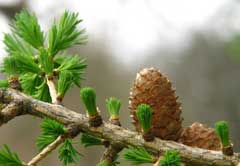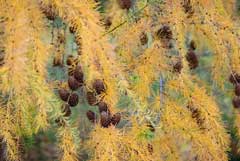 |
|
http://commons.wikimedia.org/wiki/User:Mmparedes |
 |
| http://www.flickr.com/people/10215007@N00 |
Translate this page:
Summary
Bloom Color: Red, Yellow. Main Bloom Time: Early spring, Late spring, Mid spring. Form: Rounded, Weeping.
Physical Characteristics

 Larix x marschlinsii is a deciduous Tree growing to 50 m (164ft 1in) at a fast rate.
Larix x marschlinsii is a deciduous Tree growing to 50 m (164ft 1in) at a fast rate.
See above for USDA hardiness. It is hardy to UK zone 4 and is not frost tender. The species is monoecious (individual flowers are either male or female, but both sexes can be found on the same plant) and is pollinated by Wind.
Suitable for: light (sandy) and medium (loamy) soils, prefers well-drained soil and can grow in nutritionally poor soil. Suitable pH: mildly acid, neutral and basic (mildly alkaline) soils. It cannot grow in the shade. It prefers moist soil. The plant can tolerates strong winds but not maritime exposure.
UK Hardiness Map
US Hardiness Map
Synonyms
Larix x. eurolepis. Henry.
Habitats
Woodland Garden Canopy;
Edible Uses
References More on Edible Uses
Medicinal Uses
Plants For A Future can not take any responsibility for any adverse effects from the use of plants. Always seek advice from a professional before using a plant medicinally.
None known
References More on Medicinal Uses
Now available: PLANTS FOR YOUR FOOD FOREST: 500 Plants for Temperate Food Forests and Permaculture Gardens.
An important new book from PFAF. It focuses on the attributes of plants suitable for food forests, what each can contribute to a food forest ecosystem, including carbon sequestration, and the kinds of foods they yield. The book suggests that community and small-scale food forests can provide a real alternative to intensive industrialised agriculture, and help to combat the many inter-related environmental crises that threaten the very future of life on Earth.
Read More
Other Uses
Resin Shelterbelt Tannin Wood
Resin is extracted by tapping the trunk, it has a wide range of uses including wood preservatives, medicinal etc. The bark is a source of tannin[229]. A fast growing, wind-resistant tree, it can be used in shelterbelts. Wood - strong, heavy and durable[229].
Special Uses
References More on Other Uses
Cultivation details
Landscape Uses:Specimen. Prefers an open airy position in a light or gravelly well-drained soil[200]. Plants are intolerant of badly drained soils, but they tolerate acid and infertile soils[200]. Succeeds on rocky hill or mountain sides and slopes[200]. A north or east aspect is more suitable than west or south[1]. This species is very cold-hardy when fully dormant, but the trees can be excited into premature growth in Britain by mild spells during the winter and they are then very subject to damage by late frosts and cold winds[1]. This is a very fast growing hybrid, it is often planted as a timber crop[185]. Young plants can put on 1.5 metres of growth a year, whilst some trees have been 16 metres tall in 15 years from seed[185]. Hybridizes freely with other members of this genus[200]. Open ground plants, 1 year x 1 year are the best for planting out, do not use container grown plants with spiralled roots[200]. Plants transplant well, even when coming into growth in the spring[200]. Plants in this genus are notably resistant to honey fungus[200]. Special Features:
Not North American native, Attractive flowers or blooms.
References Carbon Farming Information and Carbon Sequestration Information
Temperature Converter
Type a value in the Celsius field to convert the value to Fahrenheit:
Fahrenheit:
The PFAF Bookshop
Plants For A Future have a number of books available in paperback and digital form. Book titles include Edible Plants, Edible Perennials, Edible Trees, and Woodland Gardening. Our new book to be released soon is Edible Shrubs.
Shop Now
Propagation
Seed - sow late winter in pots in a cold frame. One months cold stratification helps germination[113]. It is best to give the seedlings light shade for the first year[78]. As soon as they are large enough to handle, prick out the seedlings into individual pots. Although only a few centimetres tall, they can be planted out into their permanent positions in the summer providing you give them an effective weed-excluding mulch and preferably some winter protection for their first year. Otherwise grow them on in the cold frame for their first winter and plant them out in early summer of the following year. The seed remains viable for 3 years[113]. This species is a hybrid so seed will not come true to type. If you are growing larger quantities of plants, you can sow the seed in an outdoor seedbed in late winter. Grow on the seedlings in the seedbed for a couple of years until they are ready to go into their permanent positions then plant them out during the winter.
Other Names
If available other names are mentioned here
Native Plant Search
Search over 900 plants ideal for food forests and permaculture gardens. Filter to search native plants to your area. The plants selected are the plants in our book 'Plants For Your Food Forest: 500 Plants for Temperate Food Forests and Permaculture Gardens, as well as plants chosen for our forthcoming related books for Tropical/Hot Wet Climates and Mediterranean/Hot Dry Climates. Native Plant Search
Found In
Countries where the plant has been found are listed here if the information is available
Weed Potential
Right plant wrong place. We are currently updating this section.
Please note that a plant may be invasive in one area but may not in your area so it’s worth checking.
Conservation Status
IUCN Red List of Threatened Plants Status :

Growth: S = slow M = medium F = fast. Soil: L = light (sandy) M = medium H = heavy (clay). pH: A = acid N = neutral B = basic (alkaline). Shade: F = full shade S = semi-shade N = no shade. Moisture: D = dry M = Moist We = wet Wa = water.

Expert comment
Author
Coaz.
Botanical References
Links / References
For a list of references used on this page please go here
Readers comment
| Add a comment |
|
If you have important information about this plant that may help other users please add a comment or link below. Only comments or links that are felt to be directly relevant to a plant will be included. If you think a comment/link or information contained on this page is inaccurate or misleading we would welcome your feedback at [email protected]. If you have questions about a plant please use the Forum on this website as we do not have the resources to answer questions ourselves.
* Please note: the comments by website users are not necessarily those held by PFAF and may give misleading or inaccurate information.
To leave a comment please Register or login here All comments need to be approved so will not appear immediately.
|
Subject : Larix x marschlinsii
|
|
|
|